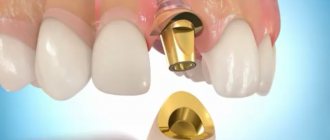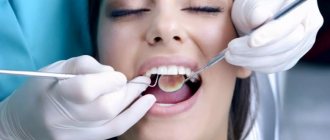In general, the condition of the front teeth greatly affects the aesthetics of your smile. Darkening of the front tooth makes patients want to solve the problem of darkening as quickly as possible - this is a good motivation to visit an endodontist. Especially if you are going to correct your bite using aligners or braces. If a patient’s tooth has darkened, this is a unique and timely motivation to take care of the health of their teeth.
Agree, when even one front tooth has darkened, this is a serious aesthetic problem that affects the eyes of others!
We asked our colleague, chief physician of the German Implantology Center Magomed Dakhkilgov, to talk about the problem of darkened teeth and ways to solve it.
For reference:
Magomed Dakhgilkov - maxillofacial surgeon, implantologist, orthopedist.
The total work experience is more than 20 years, more than 5 thousand dental surgeries have been performed. The doctor who created the German implantology clinics, which today are the best in ratings both in Moscow and in Russia. In his clinics, doctors work exclusively using a microscope and use an analytical approach to dental treatment with maximum preservation of nerve endings. The doctor’s motto is “ The tooth must live
.”
Main reasons
Why can one or more teeth turn blue? There may be several reasons for this; sometimes there is nothing dangerous to health in this process, and sometimes this is a reason to urgently seek advice from a dentist. A change in shade is possible due to poor quality nutrition or adherence to a strict diet. This can also happen if you eat a lot of fresh berries, such as blueberries, blueberries or blackberries.
Newly installed fillings may differ in color from natural tissues. A pulpless, that is, dead tooth can also change its color. This is explained by the fact that when the pulp is removed, nutrients stop flowing to the tissues.
If a seemingly healthy tooth begins to turn blue, this may indicate that there are problems with the root system. This is usually preceded by serious dental diseases. In addition, the cause of blue enamel may lie in the patient’s body; this phenomenon may be caused by the presence of chronic diseases or problems with the digestive system. Another common reason is the use of low-quality water with high levels of iron.
Why does the tooth turn black?
Crowns help restore the integrity of the dentition and maintain the structure of periodontal tissue. If before prosthetics the color of the unit was natural, and the transformation occurred subsequently, then the reasons for the darkening of the tooth may be
:
- Imperfect processing and unskilled treatment of a decaying tooth before prosthetics.
- Ignoring a crack in a ceramic crown. Especially from the reverse side, when there is no violation of visual aesthetics.
- Formation of a pocket between the gum and crown. Radical caries begins, bacteria and food debris get under the crown.
- The appearance of a gap between the crown and the ledge formed during tooth processing. Why does this happen? Perhaps the impression was taken incorrectly or the technician made an error. Or the patient refused a temporary crown, and minor deformation of the ledge occurred between treatment and installation.
Sometimes a patient has a metal-ceramic crown, and he is worried because of a dark stripe in the root zone of the chewing tooth. It is worth visiting a doctor, but for the most part, the reason is that the frame below is not covered with a sufficient layer of ceramics and over time begins to show through. The integrity of the prosthesis is not threatened. The defect is only aesthetic.
Another point:
the front teeth or molars may be over-prepared, under the gum. Soft tissues may react with recession, part of the enamel between the gum and the denture will be exposed and the process of destruction will begin.
Also the cause may be somatic ailments, metabolic disorders, chronic gastrointestinal diseases.
Treatment of blue teeth
If during diagnostics it is determined that the cause of blueness of all teeth is the use of special products, the dentist or hygienist may prescribe a professional cleaning of the oral cavity. Quite often the patient requires enamel polishing; this allows for the best results.
If after such manipulations the blue discoloration does not disappear, you can try other methods.
First of all, the doctor should send the person for an X-ray examination of the jaw, this will make it possible to make a correct diagnosis, as a result of which the treatment will be as effective as possible. It may also be necessary to remove previously installed fillings and caries-infected hard tissues. If necessary, treatment of the annals and root system of the tooth will be prescribed.
There are several methods to restore the original whiteness of your teeth. One of the most common options is the installation of a composite filling, that is, direct artistic restoration of a row. A more expensive procedure is the production of an artificial crown or special onlays - veneers (indirect restoration).
How to eliminate darkening of a tooth
If your tooth has darkened, a very effective method of solving the problem is the method of internal whitening of the darkened tooth.
With this method, the old filling is removed, the tooth canal is cleaned using a microscope, and a whitening substance is placed inside the tooth. After a couple of days, this substance is removed and a filling is placed on the tooth. The tooth is lightened - the problem is solved! As a rule, I re-treat the root canal of a darkened tooth under a microscope, then whiten the tooth from the inside, strengthen it and restore it with a filling. If the outer surface of the enamel is not damaged, the filling can be installed on the inside of the tooth.
Why does such a tooth need to be treated first? If you leave the infection in the tooth canal, the darkening process will continue, and the inflammation will spread to the bone around the root. As a result, the patient may be left without a tooth altogether.
It is the treatment of the tooth under a microscope that is aimed at completely removing the infection from the tooth cavity and root.
Blue gums
Another common phenomenon, especially in young children, is blue discoloration of the gum tissue. It often occurs during the eruption of the first, baby teeth. During this process, inevitable damage occurs to tissues penetrated by a huge number of blood vessels of different sizes. As a result, blood can enter the soft tissue, leading to the formation of a small hematoma.
That is why, if a baby has a hematoma or bruise in a place where a new tooth is expected to appear soon, there is no cause for concern. However, in all other cases it is recommended to show the child to the dentist. The cause of blueness may be an inflammatory process. It is usually preceded by diseases such as gingivitis or stomatitis.
It is important that such complications usually occur in children with weakened immune systems. Also, the health of teeth and gums is greatly influenced by compliance with the rules of daily care. Due to the abundant accumulation of plaque and stone, most ailments appear; this is especially dangerous at an early age, when the enamel is not yet strong enough.
Types of darkening of restorations
Most often, fillings on teeth darken evenly. Fresh fillings may become stained in the first hours after placement if you consume coloring products. Old restorations are also subject to uniform discoloration:
- due to the effects of low and high temperatures,
- narrowing or expansion of the filling.
Less commonly, composite restorations darken around the perimeter. This occurs due to the fact that the filling material has not completely filled the carious cavity. Pathogenic microorganisms and food particles penetrate into a small crack, which leads to darkening and destruction of the filling.
Associated symptoms
Gums can turn blue not only in the youngest patients, but also in adults. As a rule, this pathology is accompanied by many other symptoms. Most often, a person experiences noticeable pain, especially with accidental contact with tissue or with solid food, and the gums may swell and bleed.
If the cause of darkening or the appearance of age spots lies in the inflammatory process, the following symptoms can be diagnosed: severe fever and chills, itching and burning, the appearance of blood or purulent discharge, and others. In this case, immediate treatment is required in a dental clinic; traditional methods will not be effective.
If the cause of darkening of the gum or tooth is the incorrect installation of a prosthesis or crown, the patient may complain of pain even at rest, as well as slight tingling and numbness of the tissue (a sensation similar to what happens after the end of anesthesia).
previous post
How is a general examination at the dentist performed?
next entry
Prevention of complications after treatment
Regardless of the color of the gums, every person when caring for them must adhere to the following rules:
- brush your teeth every day after breakfast and before bed;
- the brush should be directed from top to bottom on the upper jaw and from bottom to top on the lower jaw;
- the procedure should be completed with circular movements from the molars to the anteriors;
- horizontal movements of the brush can injure the mucous membrane, as can very hard bristles.
Following these recommendations will help keep your gums healthy under any circumstances.
What to do with a darkened tooth
If a tooth has darkened, the first thing to do is to determine the cause of the problem. The situation with coffee lovers and smokers is clear - they should have their teeth professionally cleaned by a specialist and adjust their habits. In the future, you can sign up for whitening, but first you will have to prepare yourself mentally, because after it, smoking and drinking coloring drinks are strictly prohibited for some time.
If the enamel of your teeth has darkened due to medications, then you need to either limit their intake or switch to other medications if the attending physician approves. To reduce your exposure to liquid coloring medications, drink them through a straw. If it is impossible to change the therapy, and the pigmentation causes severe discomfort, then installing veneers will help - plates that replace the top layer of enamel.
Only a qualified dentist can make a correct diagnosis. Therefore, the best thing to do if a tooth has darkened is to go to see a doctor. It will determine the presence or absence of a pathological process. There is no need to postpone your visit. If the cause of the color change is inflammation, then an assessment of the situation by a specialist is necessary. Internal inflammatory processes are not always accompanied by acute pain. If you neglect other signs, then you may subsequently encounter not only chronic pulpitis, but also other unpleasant pathologies, such as granuloma, periodontitis, and radicular cyst.
Granuloma and cyst are formations with purulent or serous fluid inside. Their development can proceed practically asymptomatically for some time, making itself known only by a change in color. But then you cannot do without serious interventions: cutting tissue, removing part of the root, or even the entire tooth. Purulent inflammation can even damage the jaw bone. In this case, you cannot do without tooth extraction.
Removal is necessary in the following situations:
- the inflammation spread to the area around the tooth and affected the jawbone;
- the tooth is loosened and the gums are bleeding due to internal injury;
- the crown is too destroyed, less than 30% of hard tissue remains;
- the tooth is split, and the split continues inside the gum.
In the latter case, it is possible to preserve the roots of the tooth, but the cracked upper part will still be removed and replaced with a prosthesis.
It is clear that if a tooth suddenly darkens, an examination should be done immediately. To save a tooth, you need to see a dentist immediately. If there is inflammation, the doctor will remove the infected tissue and fill the voids. After treatment, it may be necessary to bleach not the outer part, but the inner part of the crown, since it was this part that darkened due to the death of the pulp or its remains. Often after this, the teeth return to their former whiteness and natural appearance. In other cases, when lightening and restoration with filling materials are impractical, but removal is not required, partial or complete “artificial enamel” is created for the tooth - veneers or crowns are installed.
To whiten a pulpless, darkened tooth, the doctor brightens it from the inside. To do this, he opens the canals, cleans them and fills them with a bleaching compound. Until the composition lightens the tissue, the patient will have a temporary filling. This procedure is called endobleaching. In some cases, it may take several sessions.
If the tooth walls are too thin, or there are other contraindications for whitening, then, depending on the situation, the dentist will select alternative methods: direct restoration with composite material, installation of veneers, lumineers or crowns. Positive aspects of restoration with composite material:
- ease of implementation - the tooth is covered with a composite composition, forming one large filling on its surface;
- speed of implementation - can be done in one visit to the doctor;
- affordable price.
Disadvantages of such restoration:
- composite material is easy to paint, you will have to change your eating habits;
- fragility - average service life is about 5 years;
- During repeated restoration, the integrity of the tooth walls suffers.
When to see a doctor
There are situations in which it becomes impossible to visit your doctor. In such cases, you should remember about the serious causes of blue gums that require urgent treatment:
- cyanosis does not subside within 4–5 days;
- in addition to changes in gum color, there are signs of local inflammation (hyperemia, swelling of soft tissues, bleeding gums);
- I am concerned about acute pain that is not relieved by painkillers;
- a sharp increase in body temperature to 38–39 degrees;
- deterioration of the general condition of the body, weakness.
Ignoring a dental problem is fraught with the development of serious consequences. Severe complications include: the formation of a benign or malignant tumor, as well as the occurrence of an intraoral cyst.











